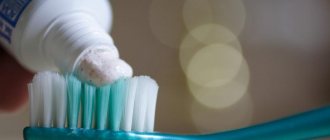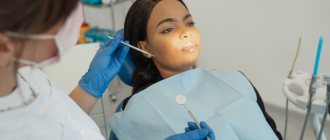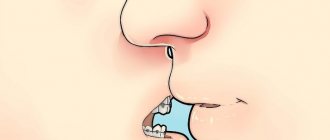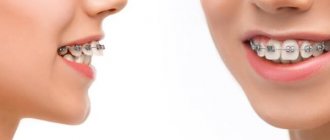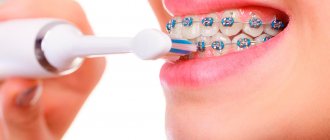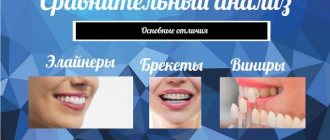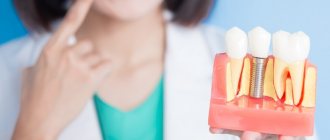The brushes are included in the kit for caring for teeth with braces.
Externally, this brush has an elongated handle and a removable elongated head. This device is very effective for hard to reach places. Removing tiny food particles helps prevent tooth decay and other diseases.
On sale you can find brushes with several interchangeable nozzles of different lengths. The longer ones are for the front incisors, and the shorter ones are for the back molars. In addition, they may vary in the stiffness of the bristles. Dentiki doctors recommend replacing tips after two weeks of use.
When moving, you should be careful when pressing so as not to injure the gums.
Other devices
We include two auxiliary tools in this category:
- Irrigator. It delivers a thin stream of water or solution under pressure, which “knocks out” food particles.
- Flosses. This is a convenient device for using dental floss. The best thread is fluorine-containing, waxed. This strengthens the enamel and prevents the appearance of caries.
What can you eat in the first days after getting braces?
Almost immediately after fixing the brace system in the oral cavity, the patient will experience unpleasant sensations associated with increased pressure on the dentition. Chewing may cause severe pain. Therefore, experts recommend in the first days to give preference to soft and strained food. The following products and dishes are optimal:
- liquid porridge;
- soups;
- cottage cheese;
- kefir;
- yoghurts;
- jelly;
- vegetable puree, etc.
What toothbrushes should you buy to care for braces?
For complete care, one v-shaped brush is not enough. In order to be sure that the teeth under the braces system are perfectly cleaned, you need to have several more types of brushes in your arsenal.
Interdental.
This type is used to clean spaces between brackets as well as areas under metal arches. Interdental brushes are available in different sizes, so they can also be used for deep cleaning of interdental spaces.
Mono-beam.
The mono-beam brush has a curved shape, thanks to which it can reach even the most difficult to reach places. This type of brush is intended for caring for braces, not teeth. Even the smallest clasps and ligatures will be perfectly clean with daily use of mono-tuft brushes.
It is worth knowing that any type of brush will wear out several times faster. This is due to the fact that when cleaning a metal system, the bristles can be pulled out. Therefore, you will have to change all care accessories much more often than recommended on the package.
What food is preferred throughout treatment?
When the patient gets used to the brace system, you can gradually expand the diet. The following is a list of products that will not cause any harm to the orthodontic structure:
- soups;
- yoghurts, kefir;
- soft cheeses;
- soft chicken fillet, thin sliced meat;
- fish, crab sticks;
- eggs;
- pasta;
- boiled rice;
- mashed potatoes;
- soft pastries, pancakes, bread crumbs;
- applesauce;
- bananas;
- jelly;
- milkshakes;
- vegetable caviar, stewed vegetables;
- cutlets, pureed meat.
The list of recommended products is quite large. It is important to understand that you should not bite hard food with your teeth. But if, for example, you grate an apple or carrot, you can eat them without fear for the safety of your braces.
Good to know. Braces are the best “nutritionist”. By adhering to some dietary restrictions, patients will receive not only straight and beautiful teeth, but also a slender figure.
Features of caring for sapphire braces
Adult patients prefer polymer materials to metal that is too visible. Sapphire braces are transparent, lightweight and ultra-thin, which allows you to avoid drawing unnecessary attention to your smile. In general, caring for sapphire braces is practically no different from the above rules. However, orthodontists recommend remembering several important nuances. Firstly, it is forbidden to smoke, drink tea and coffee in large quantities. Violating this rule will result in expensive transparent braces acquiring a yellowish tint. You will also have to rinse your mouth not twice a day, but after each meal. After all, any dirt stuck behind the ligatures will be visible to others.
We must not forget that the polymer material is quite fragile. Orthodontists recommend purchasing a special protective mouthguard, which must be worn whenever active sports are planned.
If you adhere to all the above rules, then you don’t have to worry about the condition of your teeth after removing braces.
Can braces come off?
The system is securely, but not tightly, attached to a special glue, and when biting on some products, its elements may come off. This most often occurs when eating solid foods. If one or more braces come off, you need to consult a doctor.
You can install braces at the Saint-Dent Clinic in Moscow. Qualified dentists of all specializations work here. The clinic uses advanced technologies and modern materials to treat patients. The contact page is located here Contacts. Patients can find out the cost of dental services here Prices for dental services.
What products are prohibited?
Of course, after some time the diet can be expanded. However, some things are best avoided until the moment your braces are removed. For example, biting into very hard fruits or vegetables, crackers and nuts can break the metal wire that connects all the staples. When an archwire is damaged, the pressure exerted on the teeth immediately changes. As a result, treatment may be less effective or completely useless.
Dense and sticky foods can cause staples to peel off from the enamel. Of course, thanks to the use of dental glue, they are attached quite reliably, but it is better not to take risks. First of all, you should give up foods such as seeds, nuts, dried fruits, crackers, caramel, candies, apples, carrots, etc.
In addition, sticky products are also prohibited. This includes toffee, nougat, dried fruits, cheese and much more. They can stick to the surface of the braces and accumulate in hard-to-reach places under the archwire and brackets. Removing them even with a toothbrush and irrigator can be very problematic. It is recommended to limit the consumption of fresh bread, chewing gum and even corn flakes. Dentists advise you to temporarily stop eating coloring foods, for example, beets, candies with a high content of dyes, etc. Otherwise, the staples may become stained and lose their attractive appearance.
Hard and sticky food
Eating solid foods leads to damage to the arch structure and displacement of the dentition. This also often causes locks to come unstuck. The following products are completely prohibited:
- nuts;
- crackers;
- seeds;
- hard treats (lollipops, caramels);
- hard fruits and vegetables.
Sticky and viscous products heavily contaminate the teeth and components of the orthodontic apparatus and are quite difficult to remove. They also cause the development of caries and inflammatory processes in the gums. You should refuse:
- soft sticky candies;
- chips;
- buns
- corn sticks and flakes;
- cheese;
- chewing gum.
All about braces care
- How to care for braces after installation?
- Minimum contents of a braces care kit
- Basic rules for caring for teeth with braces
- What braces care products do orthodontists recommend using?
- Orthodontic wax and irrigator: additional elements of the standard set
- Features of caring for sapphire braces
The procedure for straightening teeth and correcting bite is considered one of the longest and most difficult in dental practice. The bracket system is quite expensive, and without regular maintenance it will require replacement before the end of its intended service life. That is why it is necessary to strictly adhere to hygiene rules and do not forget to clean your braces daily.
Of course, there is always a risk of physical damage to an expensive structure due to an impact, but much more often the consumption of “forbidden” food leads to deformation. Any sticky or hard foods should be completely excluded from the diet. Taffy, caramel and chewing gum are especially dangerous. Tiny particles can get behind structural elements and begin to attract the remains of other food. Over time, plaque forms behind the ligatures.
Hot and cold food
Even people with absolutely healthy teeth should not expose their teeth to sudden temperature changes. And if a person wears braces, eating too hot and cold food is completely prohibited. This is especially true for bracket systems, which contain thermoactive elements that can change their properties under the influence of temperature.
You should avoid the following foods:
- cold ice cream and desserts;
- hot soup;
- scalding coffee, tea and other drinks.
Basic rules for caring for teeth with braces
As mentioned above, proper care of the braces system begins with brushing your teeth. Using circular movements, it is necessary to clean each tooth from the outside and back. When using an electric toothbrush, it is strictly forbidden to press the head too hard against metal elements. This risks causing the bristles to break out and get stuck in the ligatures.
Next, you need to use a floss toothpick or a special brush to remove plaque from the interdental spaces. But to remove food debris directly from under the braces, waxed dental floss is suitable. To clean, you need to tear off about 30 centimeters of thread and carefully insert it under the staple. Then pull the thread under the rings and holes in the locks and make several cleaning movements. Repeat the procedure with each tooth. Next, you can begin to carry out the above-described care program directly for braces, after rinsing your mouth with salt water or a special solution.
Drinking alcohol and smoking during braces treatment
Drinking alcoholic beverages is undesirable, as they contain large amounts of sugar, which has a destructive effect on teeth. After drinking even a small amount of alcohol, a wearer of braces will have to brush their teeth. If this is not done, in the future you will have to deal with caries and inflammatory processes of the gums. In addition, alcohol leads to dry mouth. And this entails the occurrence of wounds and ulcers.
Smoking can spoil the appearance of the structure by staining some elements. It also leads to staining of tooth enamel, but in the places where braces are attached, the enamel will remain the same color. As a result, after removing the system, contrasting stains will be visible on the teeth. It is very difficult to even out the color, since nicotine is difficult to lighten. If you cannot completely quit smoking, you must at least reduce the number of cigarettes you smoke.
Millions of people around the world have chosen braces as a means of correcting their bite. Many people complain about this aesthetic problem. But how effective is wearing braces? Are there any side effects?
According to the results of recent research in the field of orthodontics, wearing braces leads to serious changes in the oval of the face. This conclusion was reached by two well-known world-class experts - Eric Gibbs from the USA and Mike Mew from the UK. They have been sharing their opinions with patients and the public for over 10 years through publications in scientific journals and speaking engagements. But for most people, braces are still the #1 choice for correcting malocclusion. Next, we'll look at why trying to improve your appearance with braces can backfire.
Shocking facial changes
Experts in the field of orthodontics are reluctant to admit the indisputable fact that braces cause harm to those who use them, although they see the results of this method of bite correction right in front of them every day. When viewing their own photographs taken before and after orthodontic treatment, many patients are horrified and make complaints to the “specialists”. But the latter only shrug their shoulders or even refer the patient to a psychotherapist. The main problem is that patients are not warned about the possible consequences.
Braces can harm not only a person’s appearance, but also their health, including psychological health, since the results obtained often sharply reduce the patient’s self-esteem. This applies to the greatest extent to women who always want to look attractive. Practice shows that braces can change the facial features of even a naturally pretty girl. Natural beauty will not disappear, but the face loses some oval prettiness and looks more mature. It turns out that while wearing braces you can get a serious visual “increase” in age. According to the famous Russian doctor A.O. Savinova, the changed face will look like an “old woman’s face.”
Collecting data on the negative consequences of wearing braces on the shape of the face is the life's work of the American scientist Dr. Gibbs. The research results confirm what is already clear to many - orthodontic braces lengthen the face in the vertical direction. It is also known that the degree of influence on the shape of the face that braces have is related to the direction of facial growth. After wearing braces, people with so-called horizontally developed faces look best.
The main differences between “before” and “after”
The presented photos demonstrate the differences in the location of the upper jaw in the two girls, and how much this affects their appearance. In the first girl, the upper jaw is extended forward, and in the second, it is pulled down. The different structure of the upper jaw is not due to genetic factors, but to environmental influences. The latter, according to Dr. Mew, include the consequences of birth trauma, lack of breastfeeding, eating small amounts of solid food, pacifier or thumb sucking, and orthodontic intervention. The girl on the left is luckier, as her facial structure indicates that she grew up in more favorable conditions for the development of her face. The second girl's face looks elongated due to wearing braces. An increasing number of people are exposing themselves to such unfavorable changes.
The upper jaw, located horizontally and slightly protruded forward, is a distinctive characteristic of the faces of all cartoon characters who are positioned as handsome or beauties. The lines of their cheekbones are usually parallel to the line of the nose. If animators depict a villain, the maxillae of his face are slightly pushed back and pulled down. Similar techniques can be seen in the photo above.
The correct development of teeth is directly related to the direction of growth of the upper jaw. If it is horizontal, then the teeth do not grow as “crowded” as in the case of an elongated face and a vertically positioned upper jaw. These features were noticed and described first by Dr. Zakrisson (Norway) and subsequently by Dr. Woodside. They also noted that people with a vertically elongated face exhibit abnormalities in the development of the mandibular canines.
The development of intraoral devices that promote horizontal facial growth was started by European and American scientists in the last century. In the 80s and 90s, the world saw new devices - ALF and Bioblock, which are used to expand the upper jaw. The results of the studies are completely inconsistent with what orthodontists and dentists are taught. Despite the obvious advantages of the method used in the above-mentioned devices, it still does not receive due attention from official science and is used only in limited circles.
An illustrative example is the story of two twins, whose faces were initially absolutely identical. To treat malocclusion and crowding of teeth, they underwent two different courses of therapy. The first had his crowded teeth removed and then braces installed. The second was treated using the orthotropics method using an intraoral apparatus. A noteworthy fact is that his extra teeth were not removed. The photo shows that the first twin's upper jaw is pushed back and pulled down. This is the result of traditional orthodontic intervention. The second twin's jaw is slightly pushed forward, giving him more attractive facial features.
Reasons for lengthening the face as a result of wearing braces
When looking at photos of popular actresses and models in profile, it will become obvious that their faces have a characteristic feature - an extended upper jaw in the horizontal direction. Wearing braces leads to the opposite result - vertical stretching of the maxillae. This occurs due to many factors, but the main reason is the uniform impact of braces on all teeth of the jaws. The strongest teeth are those with powerful roots, so they take on the greatest force. As a result, there is a narrowing of the dental arches and a horizontal “pulling” of bone tissue. Installing braces does straighten teeth, but does not help achieve the desired result – a beautiful smile. They elongate the midface and make it appear flatter, which is completely inconsistent with the “model-like” look.
Changing the appearance of your face is not the only side effect of wearing straightening braces. As a result of the inward displacement of the upper jaw, the space for the tongue decreases, and snoring occurs during sleep. The best option for getting rid of snoring is to widen the upper jaw and move it forward. It follows that the traditional method of using braces to treat crowded teeth is the cause of unaesthetic elongation of the face and night snoring. A truly effective method is to widen the dental arches.
The girl in the photo did not have her upper canines erupting because there was no room for them in the dentition. Initial treatment involved surgery. But later she decided to turn to orthotropists. After a short course of therapy using the Bioblock device, sufficient space was created for normal canine growth. The girl’s father is a dentist by profession, but even he did not know about orthotropic methods, thanks to which her daughter’s face began to look more expressive and attractive.
Which method is better?
The goal of orthodontic treatment is only to straighten the teeth. But the side effects of such a procedure should force everyone to abandon it. Patients care not only about beautiful teeth, but also attractive facial features in general. Unfortunately, many who choose to wear braces are not even aware of the consequences that await them.
The main distinguishing feature of the orthotropic technique is the alignment of teeth by expanding the dental arches, rather than narrowing them. They use the Bioblock device, which has proven effective in a number of cases. The device straightens crooked teeth and helps to extend the upper jaw horizontally, making facial features more attractive. This method is advisable to use for treating children aged 8 to 12 years.
Correction of the upper jaw in adults is possible using the ALF device. This direction of medicine is called craniodontics (in our country – orthocraniodontics). The device is successfully used even for those patients who wore braces and are not satisfied with the results obtained. Unfortunately, this area of medicine has not yet received due attention in our country, but over time the situation will change, and everyone will have a chance to correct the horrific results of orthodontics.
The article uses photos from the sites claimingpower.com, forum.stom.ru, breket.info
Advice from professionals
- If the orthodontist has given the patient specific recommendations regarding what foods should absolutely not be consumed during treatment, they should be strictly followed.
- You can only chew soft foods with your front teeth. It is better to chew other foods with your back teeth.
- If the patient feels hungry and has tooth pain at the same time, it is worth drinking a cool smoothie or milkshake. The cold will ease the pain, and the drink will reduce the feeling of hunger.
- In the first days after installing the braces system, you should not touch your lower teeth to your upper teeth, as this can cause pain.
Why do braces cause irritation?
Modern metal and ceramic braces are small in size and have rounded edges. Although manufacturers try to make the design as comfortable as possible for patients, you need to get used to it, like any foreign body. But during the period of adaptation, irritation and inflammation may appear on the mucous membrane.
- The irritation may be an allergic reaction to the metal. In this case, treatment will most likely be suspended to replace the metal bracket system with a ceramic one. In order to avoid miscalculations, it is necessary to inform the orthodontist about your tendency to allergies even at the stage of choosing braces and, possibly, undergo additional examination at an allergy center.
- An orthodontic arch that is too long may be installed. By bending it, the dentist may not completely “twist” the sharp edge, which will scratch the mucous membrane and provoke the appearance of wounds.
- Quite often, the braces themselves, attached to the teeth, come off. The detached edge can also injure the mucous membrane, but on the inner surface of the lips.
All these problems can be solved with timely consultation with your doctor. The bracket will be glued, and the overly long edge of the arch will be trimmed and bent correctly. Rinsing with herbal decoctions will help quickly soothe irritated mucous membranes. A little more effort will be required if even after this the braces still rub the cheek mucosa.
Pain while wearing
In the first few days after fixing the system, you may experience some tooth sensitivity and a range of unusually unpleasant sensations.
To remove them, it will be enough to take mild analgesics; ask your orthodontist about them in advance. Believe me, this discomfort normally disappears within 8-10 days from the moment the braces are installed.
Some places where the bracket system contacts the cheek may cause pain; friction may cause small wounds there, which will heal when lubricated with a special gel (you should also ask your doctor about this). Accidental impacts should be avoided, which will also injure the oral mucosa. If this happens, don't panic. It is best to rinse your mouth with warm salt water many times throughout the day, and the wound will heal.
Minimum and maximum wearing periods
The time required to correct defects of varying severity also differs. Simple anomalies include diastema, trema, and crowding of teeth, which is caused by impaired development of the jaw. In such cases and if there is a gap due to missing teeth, the treatment period is 12 months. Two years or more - this is how long it takes to correct a distal bite, cross-row arrangement, open bite, or complex crowding.
There are cases when orthodontic treatment lasts more than 3 years. As a rule, such patients also require surgical treatment. Sometimes teeth need to be removed before braces can be installed. Indications for removal: abnormal jaw development, presence of supernumerary teeth. Extraction will free up space for movement. With the development of inflammatory processes in the mouth, allergies to components of the system and improper hygiene, the system may be removed ahead of schedule. After treatment and elimination of contraindications, braces are placed again.
Selection of type and material
Depending on the type of structure, the period of its wearing also changes. All models differ in strength and the material from which they are made. The most expensive ones are sapphire ones because they are invisible. Their wearing period is from 1 to 3 years.
A simple option is metal systems. They are very durable, treatment with such braces is faster. They create the correct pressure on the teeth. Because metal braces are very visible on the teeth, they are not suitable for everyone. Often the sharp edges of the structure injure the mucous membranes and gums. You will have to wear them from 1 to 1.5 years. Such models correct even the most complex malocclusions.
Plastic is not the best material for braces. It is very fragile, so structures are often damaged. The average duration of correction is up to 1.5 years. Ceramic systems cost less than sapphire systems. They are reliable, do not break, do not cause allergies, and are invisible. They need to be worn from one to 3 years.
Many people are interested in how long they wear braces on average, which are not visible. Lingual structures are attached to the inside of the dentition. The correction lasts from 1.5-2.5 years. Orthodontists at the Propricus clinic work with all brace systems. You can find out which one is right for you at your appointment. The doctor will offer you several options.
How long do you wear braces?
As for the time of wearing braces, they cope with their task on average in one and a half to two years.
Of course, only a doctor can predict how long braces should be worn based on an assessment of the complexity of the malocclusion, the patient’s age, as well as the results of the study and photographs.
The length of time you wear braces depends on what system is used:
- the minimum period of wearing braces is provided by self-ligating metal devices - the wearing time ranges from one year to one and a half years;
- if the patient uses lingual or ligature aesthetic or metal braces, the wearing time will be from one and a half to two years;
- Lingual systems are required to be worn the longest - at least two years, but they are increasingly preferred as patients do not want to advertise their treatment.
As a rule, it takes so much time to align the dentition, normalize the bite, and form the correct closure of the molars.
In any case, after an examination by a doctor, an approximate time frame for how long you need to wear braces will be determined. Such time limits will be more realistic, but they will also be affected by the patient’s participation in treatment - compliance with recommendations.
The most important thing in ensuring the stability of treatment results is a quality result. That is, the more thoroughly the alignment of the dentition is done and the better the bite, the more stability can be expected. Therefore, a good orthodontist will try to bring the results of therapy to the best possible. And if the doctor explains that you should still wear the orthodontic system, since there is no sufficient effect, and you can’t wait to remove it, then you should listen to the advice of a specialist.
If the braces are external, diction remains virtually unchanged
Commented by orthodontist, candidate of medical sciences Tatyana Gevorkyan
— Very often patients are puzzled by the issue of diction when wearing braces. And this doesn't only apply to adults. Almost all schoolchildren study a foreign language, and pronunciation is very important there.
This diction myth is wrong. External vestibular braces do not affect diction, since they are fixed on the outer surface of the teeth, while the tongue is located on the inside. Internal – lingual – braces “sin” with impaired diction (albeit temporarily). This is where you really need to get used to the innovations on your teeth for some time.
Stages of defect correction and expected results
Treatment with orthodontic structures can be divided into four main stages, each of which has its own time periods:
- Leveling
. It is the first stage and lasts 4-8 months. During this period, visually noticeable changes occur - the teeth in the row become straighter. - Mechanical movement
. The longest and, at the same time, the most important of all stages of treatment takes 6-18 months. Installing more rigid arches provokes the movement of teeth forward, backward and along the axis, and also creates conditions for correcting the bite. Visually, the changes may not be noticeable as a functional transformation occurs. - Detailing
. In terms of treatment, this is the final stage, which takes 2-6 months. By this time, all movements of the teeth and jaws have been completed and all that is required is sealing the contacts between the units and detailing their position. - Consolidation of results
. The retention period is usually twice as long as the time the braces were worn. In order to consolidate the results, removable and non-removable retailers can be used.
In some particularly difficult cases, the retention period can be lifelong, that is, retailers are appointed forever. You will be able to understand how much time it will take for you to consolidate the results during the treatment process, based on data about how flexible your teeth are to shifting.
How long does it take to install?
The structures are installed only on healthy teeth. Therefore, before starting orthodontic treatment, you need to undergo dental treatment. This will help reduce the risk of developing gum and dental disease while wearing it. Caries that appeared during treatment may cause dismantling of the structure. This means that treatment will have to start again. The duration of the procedure depends on the degree of the anomaly, the doctor’s experience, and the characteristics of the dental system. The time does not depend on whether braces are placed on adults or children. Non-ligature structures are easier to install. Therefore they are installed faster.
Installation steps:
- therapeutic treatment;
- professional cleaning;
- The orthodontist processes and dries the enamel;
- Glue is applied separately to each tooth and a lock is fixed to it;
- fixing the arch with clasps or ligatures;
- design correction.
Once the system is installed, it starts working immediately. That is, the teeth begin to gradually shift. The first result can be seen after 3-4 weeks. After the initial displacement, the arc pressure weakens. Therefore, you need to regularly visit the orthodontist for regular arch correction. The doctor monitors the creation of constant pressure. This is the key to effective correction of the bite and dentition. You can ask the orthodontists at our clinic at your appointment for how long braces are worn. You can sign up through the website or by phone.
How long to wear elastic bands
Rubber bands are elastic bands. This is a small but very important detail. They are used at any stage of treatment. The principle of their influence is similar to an arc. They help guide the movement of the dentition or individual units. They are usually placed in the first six months of treatment. But it is not always the case. Elastics are used in the presence of impacted teeth. Rubber bands help the tooth quickly take its place in the row. In a distal bite, rubber bands pull the jaws closer to each other. The orthodontist decides whether to install traction bars or not. This is as important a tool as braces.
